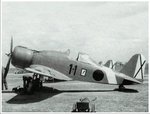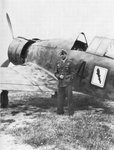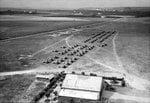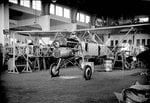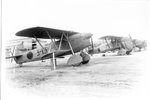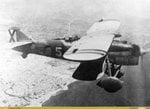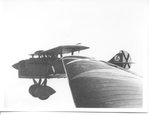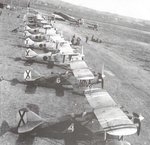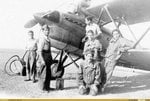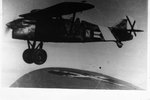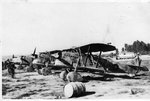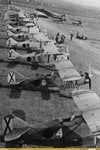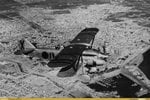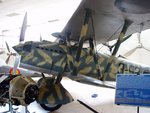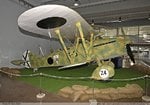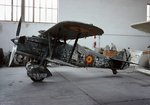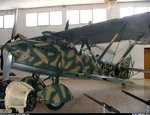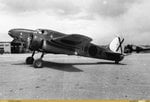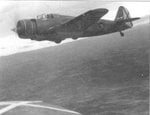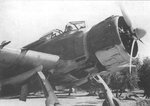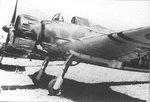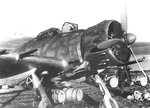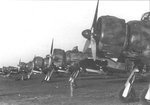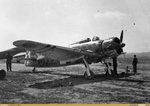Good stuff!
Navigation
Install the app
How to install the app on iOS
Follow along with the video below to see how to install our site as a web app on your home screen.
Note: This feature may not be available in some browsers.
More options
You are using an out of date browser. It may not display this or other websites correctly.
You should upgrade or use an alternative browser.
You should upgrade or use an alternative browser.
Spanish Civil War: Nationalist Air Force
- Thread starter gekho
- Start date
Ad: This forum contains affiliate links to products on Amazon and eBay. More information in Terms and rules
More options
Who Replied?- Thread starter
- #142
Design-wise, the G.50 was a standard low-wing monoplane with rounded edges, a smooth yet stout-looking fuselage and a conventional empennage. The radial engine was housed in a characteristically Fiat cowl, sporting a three-bladed propeller and conical spinner. Wings were positioned just below and ahead of the cockpit position. The canopy featured a framed forward section and a "razorback" style rear section, integrating into the tail section. The main gear systems of the undercarriage were fully retractable while the tail wheel was not.
In 1938, the first operational Fiat G.50 aircraft were delivered to the Regia Aeronautica. During the Spanish Civil War, about a dozen of G.50s were sent to Spain to reinforce the Aviazione Legionaria. The type proved extremely maneuverable, it was one of the best fighters, yet by the time World War II began it was considered to be underpowered and underarmed.
In 1938, the first operational Fiat G.50 aircraft were delivered to the Regia Aeronautica. During the Spanish Civil War, about a dozen of G.50s were sent to Spain to reinforce the Aviazione Legionaria. The type proved extremely maneuverable, it was one of the best fighters, yet by the time World War II began it was considered to be underpowered and underarmed.
Attachments
Last edited:
- Thread starter
- #143
- Thread starter
- #144
The Fiat CR.32 was an Italian biplane fighter used in the Spanish Civil War and World War II. This nimble little Fiat was compact, robust and highly manoeuvrable and gave impressive displays all over Europe in the hands of the Pattuglie Acrobatiche. The CR.32 fought in North and East Africa, in Albania and in the Mediterranean theatre. The CR.32 saw service in the air forces of China, Austria, Hungary, Paraguay and Venezuela. Used extensively in Spanish Civil War, it gained a reputation as one of the outstanding fighter biplanes of all time. But then it was overtaken by more advanced monoplane designs and was obsolete by 1939.
The Fiat CR.32 was designed by Celestino Rosatelli. Derived from earlier Fiat CR.30 designs, the CR.32 was a more streamlined and smaller biplane fighter. The prototype MM.201 first flew the 28 April 1933 from the Fiat company airstrip at Turin. The fuselage had same structure as the CR.30, utilizing aluminium and steel tubes covered by duraluminium on the nose up to the cockpit, on the back, in lower section under the tail, and with fabric on the sides and "belly". The wings and tail also had mixed structure, with aluminium frame covered by fabric. A notable feature was that the lower wing was shorter than the upper wing making it sesquiplane. Ailerons were only on the upper wings. Armament included initially two 7.7 mm (.030 in) Breda-SAFAT machine-guns (later two 12.7 mm (.5 in) Breda-SAFAT), located on top of the engine cowling, with 350 rounds each.
The Fiat CR.32 was designed by Celestino Rosatelli. Derived from earlier Fiat CR.30 designs, the CR.32 was a more streamlined and smaller biplane fighter. The prototype MM.201 first flew the 28 April 1933 from the Fiat company airstrip at Turin. The fuselage had same structure as the CR.30, utilizing aluminium and steel tubes covered by duraluminium on the nose up to the cockpit, on the back, in lower section under the tail, and with fabric on the sides and "belly". The wings and tail also had mixed structure, with aluminium frame covered by fabric. A notable feature was that the lower wing was shorter than the upper wing making it sesquiplane. Ailerons were only on the upper wings. Armament included initially two 7.7 mm (.030 in) Breda-SAFAT machine-guns (later two 12.7 mm (.5 in) Breda-SAFAT), located on top of the engine cowling, with 350 rounds each.
Attachments
Last edited:
- Thread starter
- #145
The engine was the water-cooled Fiat A.30 RA. Designed in 1930, it was a 60° V 12, producing 447 kW (600 hp) at 2,600 rpm, inspired by the American Curtiss D-12. It drove a 2.82 meter two-blade metal propeller with variable pitch ("a passo variabile") but only adjustable on the ground, not in flight. The engine did not use the usual avio-petrol but a mixture of petrol (55%), alcohol (23%) and benzole (22%). The main fuel tank, located between the engine and cockpit, carried 325 liters. There was another small tank (25 liters) in the "torpedo" fairing in the center of the upper wing. Although fully instrumented, the RA.80-1 radio was optional.
The Fiat Cr.32 was used extensively in the Spanish Civil War. At least 380 took part in the air battles fought over Spain, proving formidable adversaries to the Soviet Polikarpov I-15 and Polikarpov I-16 monoplanes that formed the back bone of the Republican air force. It had its baptism of fire in 1936. On 18 August 1936, the first 12 CR.32 Freccias arrived in Spain and formed the Squadriglia "Gamba di Ferro", "Cucaracha" and "Asso di Bastoni" of 3° Stormo. Three days later, Tenente Vittorino Ceccherelli, Medaglia d'Oro al Valor Militare (Golden Medal to Military Valour) shot down the first enemy aircraft, a Nieuport 52, over Cordoba. In total, the Italian government sent 365–405 C.R.32s to Spain while 127–131 were delivered directly to the Nationalist Aviation units. Six aircraft were captured by Republican FARE, with one sent to the USSR for evaluation.
The Fiat Cr.32 was used extensively in the Spanish Civil War. At least 380 took part in the air battles fought over Spain, proving formidable adversaries to the Soviet Polikarpov I-15 and Polikarpov I-16 monoplanes that formed the back bone of the Republican air force. It had its baptism of fire in 1936. On 18 August 1936, the first 12 CR.32 Freccias arrived in Spain and formed the Squadriglia "Gamba di Ferro", "Cucaracha" and "Asso di Bastoni" of 3° Stormo. Three days later, Tenente Vittorino Ceccherelli, Medaglia d'Oro al Valor Militare (Golden Medal to Military Valour) shot down the first enemy aircraft, a Nieuport 52, over Cordoba. In total, the Italian government sent 365–405 C.R.32s to Spain while 127–131 were delivered directly to the Nationalist Aviation units. Six aircraft were captured by Republican FARE, with one sent to the USSR for evaluation.
Attachments
-
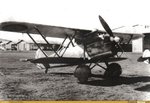 Fiat%20Cr_32%20Chirri%20005.jpg99.7 KB · Views: 300
Fiat%20Cr_32%20Chirri%20005.jpg99.7 KB · Views: 300 -
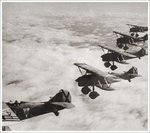 Fiat%20Cr_32%20Chirri%20004.jpg117.4 KB · Views: 309
Fiat%20Cr_32%20Chirri%20004.jpg117.4 KB · Views: 309 -
 Fiat%20Cr_32%20Chirri%20003.jpg159.2 KB · Views: 308
Fiat%20Cr_32%20Chirri%20003.jpg159.2 KB · Views: 308 -
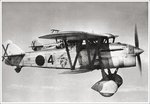 Fiat%20Cr_32%20Chirri%20002.jpg141.7 KB · Views: 302
Fiat%20Cr_32%20Chirri%20002.jpg141.7 KB · Views: 302 -
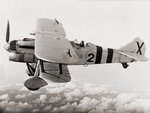 Fiat%20Cr_32%20Chirri%20001.jpg74.9 KB · Views: 304
Fiat%20Cr_32%20Chirri%20001.jpg74.9 KB · Views: 304 -
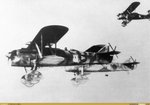 avc_00270511.jpg87.7 KB · Views: 237
avc_00270511.jpg87.7 KB · Views: 237 -
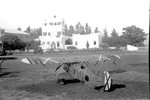 736484_10200415164205876_161707992_o.jpg76.3 KB · Views: 248
736484_10200415164205876_161707992_o.jpg76.3 KB · Views: 248 -
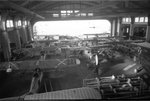 738397_10200415170046022_1515006178_o.jpg78.1 KB · Views: 254
738397_10200415170046022_1515006178_o.jpg78.1 KB · Views: 254
Last edited:
- Thread starter
- #146
Thanks to the agile CR.32, the Italians managed to obtain air superiority against its Fuerzas Aéreas de la República Española (Republican) opponents, that mainly flew a motley collection of very different aircraft. The Fiat biplane proved to be effective with Aviacion Legionaria claiming 60 (48 confirmed) modern Russian bombers Tupolev SB, once believed impossible to intercept, 242 Polikarpov I-15 biplane fighters and 240 Polikarpov I-16 monoplane fighters, plus another hundred not confirmed. Fiat C.R.32 losses were only 73. The Fiat biplanes were used for many aerobatic shows, in Italy and abroad. When foreign statesmen visited the Holy City, the 4° Stormo, Regia Aeronautica élite unit, based in Rome, put on impressive displays with formations of five or 10 aircraft. In 1936, air shows were organized in other European capitals and major cities, and, during the following year, in South America. When the team returned a brilliant display was put on in Berlin. The aerobatic characteristics of the CR.32 and its success in Spain misled the Italian air ministry, which formed the view that a fighter biplane still had potential as a weapon of war. Consequently, in May 1939, prior to Italy entering World War II, the CR.32 fighters in bis, ter and quater versions, represented two thirds of all fighters in the Regia Aeronautica.
Attachments
Last edited:
Thanks again for the pics and info...
- Thread starter
- #148
Joaquin Garcia-Morato - Best Ace of Spanish Civil War
Born in Melilla in 1904. At 19 he was called up and posted to the Infantry. In April 1925 he enrolled in the civil flying school, and on 6th August received his F.A.I. pilot's licence. Subsequently he took a course on the Avro 504 biplane and obtained the corresponding military qualification, on completion of which he was sent to a reconnaissance and bombing unit equipped with the DH9A. When the unit was sent to Morocco he took part in actions against the insurgents. He volunteered for the Bristol fighter squadron at Nador (Melilla), where in 57 missions he logged over 100 hours' flying, for which he was commended.After that he was posted to the floatplane base at Mar Chica, and later transferred to a reconnaissance group at Getafe. In 1929 he was appointed flying instructor at the pilot Conversion School. He qualified as an observer, and in 1930 as a wireless telegraphist. He learned to fly multi-engined aircraft, fighters and floatplanes, and he was an outstanding aerobatic pilot. In 1932 he added aircraft mechanic to his other qualifications. He took part in many aerobatic competitions, winning several. Among other aircraft he flew a Consolidated Fleet 2. In 1934 he saw action in the Asturias campaign.He taught blind flying at the Aereo-Club of Madrid. In 1935 Morato organised the air section of the General Directorate of Safety.
The Civil War found him on holiday (vacation) in Great Britain, from where he flew across France to Burgos and Cordoba. His part in the war started with the defence of Cordoba. Over that city on 3rd August, at the controls of a Nieuport 52, he threw an enemy formation into total confusion and forced it to withdraw. On the 12th Morato had his first victory when he shot down a Vickers Vildebeest bomber over Antequera. Garcia-Morato was one of the first Spanish pilots to fly the He-51 biplanes when they became available, and on 18th August he shot down a Potez 54 and a Nieuport while flying one. He shot down another Nieuport on 2nd September. He also piloted Ju-52s on bombing missions.
When the Fiat CR-32 fighters arrived in Spain he was the first Spanish pilot to try them out, having been posted with two comrades to one of the Italian units. On 11th September he scored his fifth victory, and his first with the CR-32, achieving three more by the end of the month. He shot down three more aircraft in October, and in November he tangled over Madrid with Russian-made I-15 aircraft, shooting down three of them - and a Potez 54 into the bargain. In December the Nationalist air force had sufficient Fiats to constitute an independent group, whose command went to Garcia-Morato. Dubbed Blue Patrol, it operated in the south flying cover for the Nationalist Breguets. The Cordoba zone was being targetted by Soviet SB-2 bombers, modern, fast and hard to intercept. On 3rd January 1937, attacking from high altitude, he pounced on a pair of them and shot them down. In February he returned to the Madrid front to support the Jarama offensive.
On the 18th, acting with other Italian CR-32 fighters, the Blue Patrol took off on a sortie to escort Ju-52 bombers. Because of losses they had sustained the Italians were forbidden to cross the front line. When the bombers crossed the front line with no escort a large number of enemy fighters pounced on them. Morato and his comrades Salvador and Berm?dez de Castro gave fight, which persuaded the Italians to disobey orders and join them. That day, at the cost of the loss of one of their own aircraft, the Nationalist flyers inflicted several losses on the enemy and redressed the balance of mastery of the air in the sector. On 17 th May, 1937 he was decorated with the Cruz Laureada de San Fernando for his actions until 18 th February, 1937. Until the latter date he had made 150 sorties and participated in 46 combats, achieving 18 victories.
Blue Patrol was upgraded to a full suqadron and later a group of two squadrons, designated 2G3. In September 1937, with a total of 27 victories, Garcia-Morato was sent to Italy, from where he returned in December that year. He was appointed Commander of the Hispana Air Brigade, embracing all air units in the north. In July 1938 he was given command of a new fighter group, 3G3, in which he increased his tally of victories to 35. On 3 rd October neither Salvador not Morato returned to base: the former had been shot down and taken prisoner and Garc?a-Morato, shot up by Third "Mosca" Squadron's Lt. Luis Sirvent Cerrillo, had made a forced landing. On 24th December his unit, Fontllonga, 20 km. north of Balaguer (Lerida), shot down nine enemy R-5 bombers, three of which were attributed to Morato. Of the 9 Natashas, 3 returned to their own side's airfields, (2 to La Garriga and 1 to Vic). Six were shot down, of which 3 were lost, while the remainder managed to land with varying fortune inside their own lines. Overall the Natasha squadron suffered 3 dead, 8 wounded and 2 taken prisoner. Garcha Morato's unit suffered the shooting down and taking prisoner of captain Rafael de Mendiz?bal Am?zaga, while another Fiat had to land because of damage at Almenar (Lerida). His last victory, number 40, was an I-15 shot down on 19th January 1939.
At the end of the war he was Chief of Operations of the Nationalist fighter force. His log book showed 1,012 hours flown on 511 sorties, of which 56 were in aerial combat, with 40 aircraft shot down. On 4th April 1939 he was putting his Fiat CR-32 (3-51) through various manoeuvres over Gri??n airfield when, during low-level inverted flight, the engine failed. The aircraft crashed, killing the pilot. He was posthumously awarded the Individual Medal and promoted to substantive major for meritorious war service. Morato's emblem is currently worn by Ala de Caza No 11 (No 11 Fighter Wing), based at Mor?n de la Frontera and equipped with the F-18. This will be the first Spanish unit to receive the Eurofighter. This Air Force unit has inherited the weapons and ancient tradition of Spanish fighter aviation which belonged to Ala 11 (11 Wing) based at Manises, Valencia until its disbandment in 1999.
Born in Melilla in 1904. At 19 he was called up and posted to the Infantry. In April 1925 he enrolled in the civil flying school, and on 6th August received his F.A.I. pilot's licence. Subsequently he took a course on the Avro 504 biplane and obtained the corresponding military qualification, on completion of which he was sent to a reconnaissance and bombing unit equipped with the DH9A. When the unit was sent to Morocco he took part in actions against the insurgents. He volunteered for the Bristol fighter squadron at Nador (Melilla), where in 57 missions he logged over 100 hours' flying, for which he was commended.After that he was posted to the floatplane base at Mar Chica, and later transferred to a reconnaissance group at Getafe. In 1929 he was appointed flying instructor at the pilot Conversion School. He qualified as an observer, and in 1930 as a wireless telegraphist. He learned to fly multi-engined aircraft, fighters and floatplanes, and he was an outstanding aerobatic pilot. In 1932 he added aircraft mechanic to his other qualifications. He took part in many aerobatic competitions, winning several. Among other aircraft he flew a Consolidated Fleet 2. In 1934 he saw action in the Asturias campaign.He taught blind flying at the Aereo-Club of Madrid. In 1935 Morato organised the air section of the General Directorate of Safety.
The Civil War found him on holiday (vacation) in Great Britain, from where he flew across France to Burgos and Cordoba. His part in the war started with the defence of Cordoba. Over that city on 3rd August, at the controls of a Nieuport 52, he threw an enemy formation into total confusion and forced it to withdraw. On the 12th Morato had his first victory when he shot down a Vickers Vildebeest bomber over Antequera. Garcia-Morato was one of the first Spanish pilots to fly the He-51 biplanes when they became available, and on 18th August he shot down a Potez 54 and a Nieuport while flying one. He shot down another Nieuport on 2nd September. He also piloted Ju-52s on bombing missions.
When the Fiat CR-32 fighters arrived in Spain he was the first Spanish pilot to try them out, having been posted with two comrades to one of the Italian units. On 11th September he scored his fifth victory, and his first with the CR-32, achieving three more by the end of the month. He shot down three more aircraft in October, and in November he tangled over Madrid with Russian-made I-15 aircraft, shooting down three of them - and a Potez 54 into the bargain. In December the Nationalist air force had sufficient Fiats to constitute an independent group, whose command went to Garcia-Morato. Dubbed Blue Patrol, it operated in the south flying cover for the Nationalist Breguets. The Cordoba zone was being targetted by Soviet SB-2 bombers, modern, fast and hard to intercept. On 3rd January 1937, attacking from high altitude, he pounced on a pair of them and shot them down. In February he returned to the Madrid front to support the Jarama offensive.
On the 18th, acting with other Italian CR-32 fighters, the Blue Patrol took off on a sortie to escort Ju-52 bombers. Because of losses they had sustained the Italians were forbidden to cross the front line. When the bombers crossed the front line with no escort a large number of enemy fighters pounced on them. Morato and his comrades Salvador and Berm?dez de Castro gave fight, which persuaded the Italians to disobey orders and join them. That day, at the cost of the loss of one of their own aircraft, the Nationalist flyers inflicted several losses on the enemy and redressed the balance of mastery of the air in the sector. On 17 th May, 1937 he was decorated with the Cruz Laureada de San Fernando for his actions until 18 th February, 1937. Until the latter date he had made 150 sorties and participated in 46 combats, achieving 18 victories.
Blue Patrol was upgraded to a full suqadron and later a group of two squadrons, designated 2G3. In September 1937, with a total of 27 victories, Garcia-Morato was sent to Italy, from where he returned in December that year. He was appointed Commander of the Hispana Air Brigade, embracing all air units in the north. In July 1938 he was given command of a new fighter group, 3G3, in which he increased his tally of victories to 35. On 3 rd October neither Salvador not Morato returned to base: the former had been shot down and taken prisoner and Garc?a-Morato, shot up by Third "Mosca" Squadron's Lt. Luis Sirvent Cerrillo, had made a forced landing. On 24th December his unit, Fontllonga, 20 km. north of Balaguer (Lerida), shot down nine enemy R-5 bombers, three of which were attributed to Morato. Of the 9 Natashas, 3 returned to their own side's airfields, (2 to La Garriga and 1 to Vic). Six were shot down, of which 3 were lost, while the remainder managed to land with varying fortune inside their own lines. Overall the Natasha squadron suffered 3 dead, 8 wounded and 2 taken prisoner. Garcha Morato's unit suffered the shooting down and taking prisoner of captain Rafael de Mendiz?bal Am?zaga, while another Fiat had to land because of damage at Almenar (Lerida). His last victory, number 40, was an I-15 shot down on 19th January 1939.
At the end of the war he was Chief of Operations of the Nationalist fighter force. His log book showed 1,012 hours flown on 511 sorties, of which 56 were in aerial combat, with 40 aircraft shot down. On 4th April 1939 he was putting his Fiat CR-32 (3-51) through various manoeuvres over Gri??n airfield when, during low-level inverted flight, the engine failed. The aircraft crashed, killing the pilot. He was posthumously awarded the Individual Medal and promoted to substantive major for meritorious war service. Morato's emblem is currently worn by Ala de Caza No 11 (No 11 Fighter Wing), based at Mor?n de la Frontera and equipped with the F-18. This will be the first Spanish unit to receive the Eurofighter. This Air Force unit has inherited the weapons and ancient tradition of Spanish fighter aviation which belonged to Ala 11 (11 Wing) based at Manises, Valencia until its disbandment in 1999.
Attachments
-
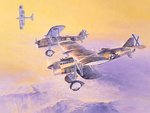 Fiat%20Cr_32%20Chirri%20en%20un%20viraj%20a%20la%20derecha.jpg98.7 KB · Views: 314
Fiat%20Cr_32%20Chirri%20en%20un%20viraj%20a%20la%20derecha.jpg98.7 KB · Views: 314 -
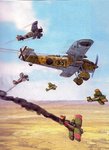 Fiat%20Cr_32%20Chirri%20Vs%20Policarpov%20I-15%20Chato.jpg416.2 KB · Views: 316
Fiat%20Cr_32%20Chirri%20Vs%20Policarpov%20I-15%20Chato.jpg416.2 KB · Views: 316 -
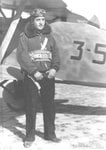 moratocr32.jpg127.5 KB · Views: 310
moratocr32.jpg127.5 KB · Views: 310 -
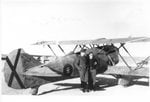 FiatCR32262.jpg56.4 KB · Views: 299
FiatCR32262.jpg56.4 KB · Views: 299 -
 FIATcr323-Logrooraroesquema.jpg64.4 KB · Views: 303
FIATcr323-Logrooraroesquema.jpg64.4 KB · Views: 303 -
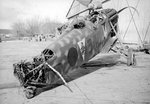 229200_185271208192371_1369664_n.jpg84.7 KB · Views: 251
229200_185271208192371_1369664_n.jpg84.7 KB · Views: 251 -
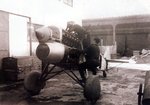 253618_194633463922812_7804604_n.jpg93.6 KB · Views: 236
253618_194633463922812_7804604_n.jpg93.6 KB · Views: 236
Last edited:
- Thread starter
- #149
- Thread starter
- #150
The Fiat Cr.32 Chirri displayed at the Cuatro Vientos Museum is a replica of the Garcia Morato´s fighter, the best ace of the Spanish Civil War, with 40 victories. As I said in the previous thread, Garcia Morato died in an accidente a few months later of the end of the war. His fighter, coded 3-51, was completely destroyed, but his squadron mates managed to build a replica, using the wrecks of the accident. This is the only remainning Fiat Cr.32 in Spain.
Thre is another example in Italiy, at the Vigna de Valle Museum. However, this fighter is a Hispano Aviacion Ha-132L, the spanish version of the italian fighter built in Spain. These fighters were used as advanced trainers, being replaced by the Mentors. One of this planes was transfered to the Museum, wearing the spanish markings used during the Civil War.
Thre is another example in Italiy, at the Vigna de Valle Museum. However, this fighter is a Hispano Aviacion Ha-132L, the spanish version of the italian fighter built in Spain. These fighters were used as advanced trainers, being replaced by the Mentors. One of this planes was transfered to the Museum, wearing the spanish markings used during the Civil War.
Attachments
Last edited:
- Thread starter
- #151
The Caproni-Begamaschi Ca.310 Libeccio (Italian: southwest wind) was an Italian monoplane, twin-engine reconnaissance aircraft used in World War II. Derived from the similar Ca.309, it had its combat debut during the Spanish Civil War, and took part in the earlier phases of World War II in Libya. Some were used in attack groups as a temporary replacement for the unsatisfactory Breda Ba.65. The last Ca.310 was retired by the Italian Air Force in 1948. The Ca.310 was designed as a low-wing monoplane reconnaissance/bomber, being essentially a version of the semi-military Ca.309 with retractable landing gear and uprated engines. The fuselage was of welded steel tube construction with a covering of light alloy panels and fabric, while the empennage/tail unit was of wooden construction with plywood skin on its fixed portions and fabric covering on control surfaces. Above the fuselage, mounted in line with the wing trailing edges was a manually-operated dorsal turret armed with a single rifle-caliber (7.7 mm/0.303 in) Breda-SAFAT machine gun.
Attachments
Last edited:
- Thread starter
- #152
A unit of 16 aircraft was sent to Spain in July 1938 for operational trials as a reconnaissance/bomber by the Italian expeditionary force operating alongside the Nationalist insurgents in the Spanish Civil War. The Caproni´s nickname was "Cabrones" (bastard in spanish), because both words sound very similar and also because the pilots used to say that the plain tried to kill them everytime they took off.
Attachments
Last edited:
Good shots!
vikingBerserker
Lieutenant General
I agree!
- Thread starter
- #155
The Breda Ba.65 was an all metal single-engine, low wing monoplane used by Aviazione Legionaria during the Spanish Civil War and Regia Aeronautica in the first part of World War II. It was the only Italian ground-attack aircraft that saw active service in this role. It saw service almost exclusively on the North African front. A total of 55 machines were exported and used by the air forces of Iraqi, Chile and Portugal.
A large number of the Ba.65s serving with Italian units were of two-seat configuration, with an observer/gunner in an open cockpit above the trailing edge of the wing. A smaller number of the type had a Breda L type turret, but in either case the observer/ gunner operated a single 7.7mm machine-gun. While offensive armament could theoretically comprise up to 1000kg of bombs, the load usually carried was up to 300kg in the fuselage bomb bay or, alternatively, up to 200kg on underwing racks.
A large number of the Ba.65s serving with Italian units were of two-seat configuration, with an observer/gunner in an open cockpit above the trailing edge of the wing. A smaller number of the type had a Breda L type turret, but in either case the observer/ gunner operated a single 7.7mm machine-gun. While offensive armament could theoretically comprise up to 1000kg of bombs, the load usually carried was up to 300kg in the fuselage bomb bay or, alternatively, up to 200kg on underwing racks.
Attachments
Last edited:
- Thread starter
- #156
Intended as an aeroplano di combattimento, capable of fulfilling the roles of interceptor fighter, light bomber, or reconnaissance/attack aircraft as required, the prototype Breda Ba.65 made its initial flight in September 1935. Experience in Spain indicated that the Ba.65 was suited only to the attack role, and the type served thenceforth with most of the eight squadriglie attached to the two Regia Aeronautica assault stormi (wings), the 5° and 50°. A second series of 137 aircraft was built by Breda (80) and Caproni- Vizzola (57), before production ended in July 1939. They differed from the first production batch by having Fiat A.80 engines. Six Fiat-powered Ba.65s and four more of the Gnome- Rhone-powered version were sent to the Aviazione Legionaria in Spain in 1938. Following Italy's entry into World War II in June 1940, Ba.65s were involved in the fighting in North Africa against the British. They had a low serviceability rate in desert conditions and put up an unimpressive performance, The last serviceable aircraft was lost during the British offensive in Cyrenaica in February 1941.
Attachments
Last edited:
Hello
We enjoyed them a lot, thanks.
But unlike for I-15 Chato that 2 were captured soon on november the 3, lost in the dark over an unknown country, landing erroneously on german used nationalist airfield, there were few captured Mosca/ Rata before the war's end.
From soviet accounts, first two I-16 were lost during their first fight on november 1936 the 13th when an inexperienced soviet squadron fought against german and maybe italian aces. One of them supposingly damaged in combat, with wounded Vladimir Botcharov on commands, successfully gears out, made a perfect
kiss landing. All perfectly except just one but fatal error, since he landed on nationalist side.
On next day his cutted in peaces body was throwen out in a box sustained by a parachute over Madrid. Weather being no flyable in most, there were meetings, soviet angry crews promissed to revenge the sadistically killed comrade and tried so immediatly but at great danger, due to stormy and cloudy sky.
Just the opposite effect in fact, that was tried to be reached by franquists: fear foreign aviators...
The first captured I-16 might be the famous "No Tocar" plane with black 9 on tail. Should it be that plane, in that case it took particulary long time to restore even after 3 -4 other captured I-16 on Santander airfield.
The I w-1 didn't fly before the 12 april 1938, anyway.
Three mounths later, José Luis Aresti ; Joseba Coldoba for it's real name that had just returned from Kirovobad school, defected from El Carmoli to Melila, and landed gears up on la Rastinga beach. It was restored and painted in nationalist colors.
On 13 september 1938 Andres Fierro Mena landed on Almanar airfield. The (nationalist biaised) historian Juan Arraez Cerda wrote before changing, that it was to join nationalist air force, just because of Cerda's "lust" of the moment. It's why A Fierro that returned quickly to FARE and became a famous as in soviet airforce during WWII, and distinguished professor in Moscow University after war, still wants to smash on his face until now, and of course kick ass. Considering Fierro's sense of honor, and physicall size, i would't advice Cerda to cross his road on Madrid streets. And this, even considering Fierro's advanced age...
Back to our buisness. All captured I-16 were exposed on Almenar airfield Lerida region. Except one as a well known fact, that went for 3-G-3 Garcia Morato's fighter group. He demonstrated it to german J/88 pilots from the end of 1938. Theese, the more they saw its flight capabilites altogether with Morato's ones, the less they wanted to fight it. It's probably why demonstrations soon ceased...
So except your I-W-I all planes of yours are not war-during captured ones.
It's the I-W-6 case, for instance
The double-six previously belonged to famous republican ace and squ. leader José Maria Bravo
The I W 30 from postwar spanish production
Regards
More pictures
Most of these fighters were captured after the end of the war, joinning the newborn "Ejercito del Aire". However, for a short period of time they served with the old air forces of the nationalist, wearing the military codes used by them during the war. This is the reason why I have included them here; enjoy the pictures.
We enjoyed them a lot, thanks.
But unlike for I-15 Chato that 2 were captured soon on november the 3, lost in the dark over an unknown country, landing erroneously on german used nationalist airfield, there were few captured Mosca/ Rata before the war's end.
From soviet accounts, first two I-16 were lost during their first fight on november 1936 the 13th when an inexperienced soviet squadron fought against german and maybe italian aces. One of them supposingly damaged in combat, with wounded Vladimir Botcharov on commands, successfully gears out, made a perfect
kiss landing. All perfectly except just one but fatal error, since he landed on nationalist side.
On next day his cutted in peaces body was throwen out in a box sustained by a parachute over Madrid. Weather being no flyable in most, there were meetings, soviet angry crews promissed to revenge the sadistically killed comrade and tried so immediatly but at great danger, due to stormy and cloudy sky.
Just the opposite effect in fact, that was tried to be reached by franquists: fear foreign aviators...
The first captured I-16 might be the famous "No Tocar" plane with black 9 on tail. Should it be that plane, in that case it took particulary long time to restore even after 3 -4 other captured I-16 on Santander airfield.
The I w-1 didn't fly before the 12 april 1938, anyway.
Three mounths later, José Luis Aresti ; Joseba Coldoba for it's real name that had just returned from Kirovobad school, defected from El Carmoli to Melila, and landed gears up on la Rastinga beach. It was restored and painted in nationalist colors.
On 13 september 1938 Andres Fierro Mena landed on Almanar airfield. The (nationalist biaised) historian Juan Arraez Cerda wrote before changing, that it was to join nationalist air force, just because of Cerda's "lust" of the moment. It's why A Fierro that returned quickly to FARE and became a famous as in soviet airforce during WWII, and distinguished professor in Moscow University after war, still wants to smash on his face until now, and of course kick ass. Considering Fierro's sense of honor, and physicall size, i would't advice Cerda to cross his road on Madrid streets. And this, even considering Fierro's advanced age...
Back to our buisness. All captured I-16 were exposed on Almenar airfield Lerida region. Except one as a well known fact, that went for 3-G-3 Garcia Morato's fighter group. He demonstrated it to german J/88 pilots from the end of 1938. Theese, the more they saw its flight capabilites altogether with Morato's ones, the less they wanted to fight it. It's probably why demonstrations soon ceased...
So except your I-W-I all planes of yours are not war-during captured ones.
It's the I-W-6 case, for instance
The double-six previously belonged to famous republican ace and squ. leader José Maria Bravo
The I W 30 from postwar spanish production
Regards
Last edited:
good shots mate!
- Thread starter
- #160
In 12/36, Mussolini decided to give his military personnel some experience in a real conflict, the Spanish Civil War. His program to assist Franco's Nationalists included the establishment of a 250-plane aerial contingent, the Aviazione Legionaria. The first installment of that force consisted of four Ba.65s unloaded on 12/28/36, to be joined by eight more on 1/8/37. In March, the attack planes were transported to Cádiz, along with newly arrived Fiat C.R.32 fighters. The last of the Ba.65s arrived on 5/3 and were formed into the 65th Squadron. Teething troubles were soon experienced with the new planes and not until August did the unit begin operations. On 8/24 one of its pilots scored a unique air- to-air victory when he encountered a lone twin-engine Tupolev SB-2 bomber over Soria and shot it down.
During operations in northern Spain, several Ba.65s were converted to two-seat planes, and one was experimentally fitted with an A360 two-way radio. At the end of the campaign in October, the squadron was transferred and in December the Bredas braved bitter winter weather conditions to take part in the battles for Teruel. After that city fell, the 65th Squadron, bolstered by the arrival of four more Ba.65s, took part in the Aragon offensive, which by 4/15 had succeeded in cutting the Spanish Republic in two. During the Nationalist advance, the Ba.65s harassed retreating Republican troops, attacked artillery batteries and landing grounds, and bombed railway and road junctions. During the Battle of the Ebro in 7/38, the 65th Squadron used its Ba.65s as dive-bombers for the first time, striking at pontoon bridges that the Republicans had thrown across the Ebro River. By 9/38, attrition had whittled the squadron's complement of aircraft down to eight, but six more Ba.65s arrived, and in 1/39 the squadron was ready to take part in the final offensive against Catalonia. The Ba.65s' final mission was flown on 3/24. When the war ended five days later, the 65th Squadron had logged 1,921 sorties, including 368 ground-strafing and 59 dive-bombing attacks. Of the 23 Ba.65s sent to Spain, 12 had been lost. When the airmen of the Aviazione Legionaria returned to Italy in May, they bequeathed their 11 surviving Ba.65s to the Spanish Air Force.
During operations in northern Spain, several Ba.65s were converted to two-seat planes, and one was experimentally fitted with an A360 two-way radio. At the end of the campaign in October, the squadron was transferred and in December the Bredas braved bitter winter weather conditions to take part in the battles for Teruel. After that city fell, the 65th Squadron, bolstered by the arrival of four more Ba.65s, took part in the Aragon offensive, which by 4/15 had succeeded in cutting the Spanish Republic in two. During the Nationalist advance, the Ba.65s harassed retreating Republican troops, attacked artillery batteries and landing grounds, and bombed railway and road junctions. During the Battle of the Ebro in 7/38, the 65th Squadron used its Ba.65s as dive-bombers for the first time, striking at pontoon bridges that the Republicans had thrown across the Ebro River. By 9/38, attrition had whittled the squadron's complement of aircraft down to eight, but six more Ba.65s arrived, and in 1/39 the squadron was ready to take part in the final offensive against Catalonia. The Ba.65s' final mission was flown on 3/24. When the war ended five days later, the 65th Squadron had logged 1,921 sorties, including 368 ground-strafing and 59 dive-bombing attacks. Of the 23 Ba.65s sent to Spain, 12 had been lost. When the airmen of the Aviazione Legionaria returned to Italy in May, they bequeathed their 11 surviving Ba.65s to the Spanish Air Force.
Attachments
Last edited:
Users who are viewing this thread
Total: 1 (members: 0, guests: 1)

